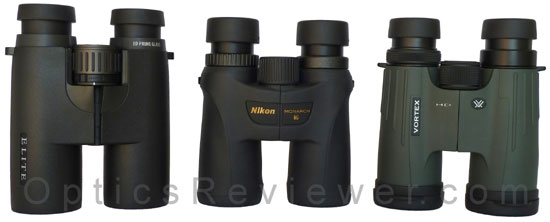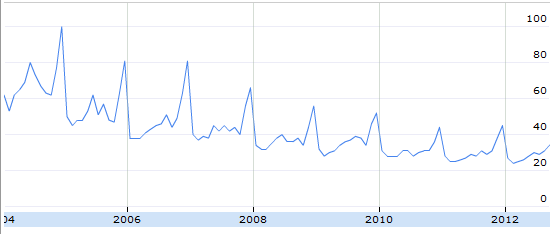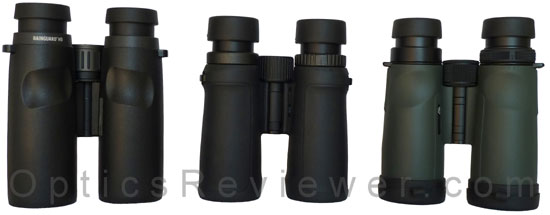Monarch 7 vs Elite ED vs Viper HD Comparison — Which Would WE Buy?
MenuSeptember 2012
Which is the better value when comparing the Monarch 7 vs Elite ED vs Viper HD? How do they compare optically? Is one built better than the other two? Why were these three chosen for a comparison? These are all good questions and we'll provide direct comparison information from our tests. As a distillation, this article touches on only the comparative aspects of the individual binocular reviews. You'll want to read the individual reviews for full information and our opinions about a model's various aspects or features.

To get an insight into the binocular companies' business, it's helpful to consider a bit of background information before we start digging into the comparison. Understanding what's taking place in the business world will help us understand what we'll see later in this article.
Starting in 2004, Google started to keep a record of searches and the time of year at which they occurred. It's interesting to compare the searches for the term "binoculars" as a more or less generic indicator of interest in binoculars.
Since it's easier to isolate a geographic area's economy and the internet traffic for a given term, let's consider the United States' economy. Beginning in late 2005 its economy began softening and increasingly continued through 2007. Internet traffic for "binoculars" began deteriorating in 2005 when the holiday shopping spike was a bit more than half of what it had been for 2004. "Binoculars" internet traffic from 2005 through 2007 gently declined with fewer spikes for those typical times for birding and hunting seasons. When 2008's recession hit, the annual "binoculars" traffic suffered significantly with a flattening of the normally fluctuating seasonal interest and the holiday shopping spikes becoming smaller and smaller from 2008 onward.
You can see the economy's impact on the overall United States internet traffic for "binoculars" on the following graph provided by Google.

So how does that relate to this article comparing the Nikon Monarch 7 vs Bushnell Elite ED vs Vortex Viper HD? We're glad you asked! We've just shared with you what we think may be a significant part of the reason Bushnell updated its Elite binocular model with ED glass and improved coatings all while significantly cutting its price. Nikon introduced its Monarch 7 model with ED glass and enhanced coatings to directly compete, we believe, with the newly improved Elite ED on both features and price. We suspect it's not a coincidence that the Monarch 7's USA price is slightly lower than that of the Elite ED.
So what, you say? What difference does that make, you ask? Just this — it's a buyer's market for these binoculars, friends. It works in our favor to be able to get a much better value than we could have gotten last year at this time.
Let's get along with this review and tell you what we found.
Construction of the Binoculars
Chassis
The respective companies told us that the Viper HD's chassis is polycarbonate and the Monarch 7's is polycarbonate reinforced with fiberglass. The Elite ED's chassis is magnesium. Our optical technician friends prefer working on a binocular with a metal frame because it's easier to repair. When polycarbonate plastics break, such as the newer, plastic car headlight lenses or hard plastic water bottles, they tend to shatter and can be difficult to piece together. Having said that, we'll quickly follow it with the fact that we've never had a polycarbonate binocular break!
Whether polycarbonate or magnesium is better for you is a decision you'll have to make. If you tend to be rough on things, you may be better off with the magnesium frame. For those who remember they're working with a precision optical instrument and treat it accordingly, a polycarbonate frame will likely do just fine.
Focus Wheel's Touch and Mechanism
The focus wheel on each of these binoculars is good. We found the Viper HD we bought had a bit more resistance to the touch than the Elite ED or the Monarch 7, but not uncomfortably so.
Those who have read more than a couple of our reviews know we tend to be enthusiastic about a focus mechanism going from close focus to infinity in a single revolution of the focus wheel. The Elite ED does just that — it goes from close focus to infinity in a single revolution. We're willing to accept as much as 1.5 revolutions of the focus wheel to change from close focus to infinity. When comparing the Monarch 7 vs Viper HD, the Monarch 7 we tested used just under 1.5 revolutions and the Viper HD was right at 1.5 revolutions.
Where are they made?
If to compare where they're made in a Bushnell Elite ED vs Vortex Viper HD comparison, they're both made in Japan. Some people put a strong emphasis on the country of manufacture.
In working with the new Nikon Monarch series, however, we felt we were seeing the results of Nikon working with a manufacturing system in China which produced Nikon quality. While no manufacturing process is perfect, regardless of where it is located, we were impressed with the Monarch 7's fit and feel as well as its optical quality.
Optical Configuration and Performance
Here is where we felt differences were noteworthy.
Field of View
We're unembarrassed advocates of a wide field of view. As one member of the team likes to say, "You'll never know what you didn't see because you had a narrow field of view!"
When comparing the Elite ED vs Viper HD vs Monarch 7, we found the 8X42 configurations had fields of view measuring 330.0ft (110.0m), 347.0ft (116.9m), and 419.2ft (127.8m), respectively. For us that gave the Monarch 7 an edge as long as that much of a field of view was actually usable. In field testing them, we found that the Nikon Monarch 7 usable field of view was quite broad and reflective of the overall wide field of view.
How did the Depth of View Compare?
With the units we used and tested, we compared the Viper HD vs Elite ED and found that they had quite similar depths of view. That is to say that if you focus on something a specific distance away, that you could see clearly those objects a certain number of feet/meters closer and further away without re-focusing the binocular. This could is a similarity to the three-dimensional effect seen in Porro prism optics. Neither the Viper ED nor the Elite ED was bad in this respect, but rather both were good.
The Monarch 7 unit we tested, however, seemed to have a significantly greater depth of view than the Viper HD or Elite HD. This increased the Monarch 7's ease of use by a considerable amount since the focus doesn't have to be re-adjusted each time you make a minor change in viewing.
Resolution of Details
When we initially published this comparison, we didn't say anything about the sharpness of details when using each of these binoculars. The reason we didn't was because it was not a factor in the comparison between them. To say it differently, as we tested each of our copies of the models, we didn't significant difference between them. Consequently, we felt it wasn't meaningful to this comparison to include compare/contrast information.
Colors Viewed
We didn't notice a significant difference between these three binoculars in the colors viewed in the field. Each of the three binoculars uses extra-low dispersion (ED) glass, although the Viper HD refers to it as "High Density" glass. Of course, with any manufacturing process there will be some variation between units, however we would not expect those differences to be extraordinary.
How do they Compare with Low Light Viewing?
To be fair, we need to point out that we were using two different configurations. We had purchased a 10X42 Viper HD, but both the Elite ED and Monarch 7 we bought were 8X42 configurations. We would expect the Viper to be a bit darker because of its higher magnification with the same objective lens size.
Having said that, however, and trying to compensate for it, we felt that the Elite ED and Monarch 7 might be a tiny bit brighter than the Viper HD. The OpticsReviewer.com team was about evenly split as to whether or not the Monarch 7 might be just barely perceptibly brighter than the Elite ED. If the Monarch 7 is brighter than the Elite ED, it's just barely noticeable by the naked eye.
Strong Light Viewing
The Elite ED and Monarch 7 did a little better at handling strong light than the Viper HD. This will be most likely to show up when looking over a reflective surface, such as snow, water, or ice, in sunny conditions. You may not encounter conditions like that frequently, but, when you do, you tend to remember it!
What About Differences in Warranties?
The differences in warranties may be significant, depending on how one is approaching the purchase.
It may not be obvious, but a company like Vortex has to include the expected warranty cost in the price for any product. Since the Vortex warranty is transferrable, this represents a potentially significant future liability for the company — they're effectively insuring a Vortex binocular against any future problem short of your losing it or it being stolen and extending the same warranty to anyone you might sell or give that binocular to as well. In an ideal world, this should result in a higher value when you sell your Vortex binocular.
A Nikon warranty is similar in that it covers pretty much anything that might happen to the binocular, but they're only extending that to you as the original owner for twenty-five years. That's still a long time and likely longer than you'll actually be using the binocular. Because the warranty isn't transferrable, they won't have any liability to anyone you might sell or give the binocular to and that reduces Nikon's warranty cost considerably, which is reflected in its consumer price. If you plan on keeping a Nikon product rather than selling it soon, you'll pay less for its warranty as compared to a Vortex product.
Similar to Nikon's in several respects, Bushnell provides a limited lifetime warranty to the original owner of the instrument which is not transferrable. As with Nikon's warranty, the company's liability to each owner after you is not included in the price you pay for the binocular.

Recommendation
Each of the three binoculars is strong from a construction and optical perspective and will serve a person admirably for a broad range of activities.
For our money, the balance is tipped in favor of Nikon's Monarch 7 binoculars for three reasons. Firstly, the field of view is terrific and we love it. You'll see more action with it than with a narrower field of view. Secondly, the depth of view is better with the Monarch 7 than with either the Elite ED or the Viper HD. Lastly, the fact that the Monarch 7's price is slightly less than that of either the Elite ED or the Viper ED as this article is written!
We quite understand that some people don't care for a wide field of view, for example, with all of the distractions they feel it presents. For others, an absolute warranty provides a desired level of comfort or perhaps a necessary level of protection for the instrument. The Elite ED and Viper HD are both very good binoculars in their own right.
For your convenience, each of the following links will take you to the selection of that particular binocular carried by the retailer. As people who love using binoculars, we want to make your shopping as enjoyable as possible.
For those shopping for the Nikon Monarch 7, these links will take you to the selections on hand at
Amazon.com
and Amazon.co.uk
. We like doing business with them.
To shop for the Bushnell Elite ED, these links will take you to the ones available from
Amazon.com
and Amazon.co.uk
.
You'll enjoy shopping for the Vortex Viper HD by following these links to the selection stocked by
Amazon.com
and Amazon.co.uk
.
Because we left a lot of interesting information and test results out of this brief comparison article, we also recommend reading each of the individual reviews to get an overall feel for the instruments. These are links to the Bushnell Elite ED review, Nikon Monarch 7 review, and Vortex Viper HD review. We're delighted to have the opportunity to work with the Elite ED, Monarch 7 and Viper HD binoculars — we consider each of them to provide excellent optics in their own right.
Home > Binocular Comparisons > Monarch 7 vs Elite ED vs Viper HD


Your Comments
This site is for you, our readers. We appreciate your comments very much.